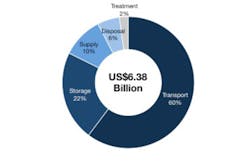Wastewater treatment spending for hydraulic fracturing is expected to grow almost three-fold, from $138 million in 2014 to $357 million in 2020 in the U.S., according to a new report from Bluefield Research.
The U.S. hydraulic fracturing industry consumes over 1 billion barrels of water annually, producing 450–500 million barrels of contaminated water for disposal, with only about 14 percent treated and reused. Bluefield cites water supplies increasingly at risk, tighter regulations emerging in key states, and costs of disposal on the rise as factors contributing to the substantial rise in water treatment and reuse, which is expected to account for 27 percent of total produced and flowback water by 2020.
Overall, the U.S. hydraulic fracturing industry, will spend $6.38 billion in 2014 on water management—water supply, transport, storage, treatment, and disposal. Water transport and disposal costs will account for 66 percent of the total water management spent this year, with treatment comprising roughly 2 percent.
Bluefield reports water scarcity in Western U.S. states has had little impact to date on fracturing water supply, but that is likely to change if droughts persist. Meanwhile state regulators are beginning to tighten control of produced water disposal. In Pennsylvania, where state policymakers in 2010 placed discharge limits on wastewater from unconventional oil and gas operations, statewide treatment and reuse rates for the Marcellus Basin have jumped to 90 percent in 2014.
READ ALSO: New Tracers Can Identify Fracking Fluids in the Environment
The increasing cost of transport and injecting water into wells—now accounting for 66 percent of water services spending—and the improving cost structures of treatment provide another driver of reuse, Bluefield reports. According to the report, well operators that employ treatment and reuse solutions spend on average $8.80 per barrel of water used compared to $10.20 per barrel of water trucked and injected into wells, although cost comparisons are site specific.
“Fracking has been the Wild West for the U.S. water industry,” said Reese Tisdale, president of Bluefield Research. “There are three reasons for this: first, there has been an explosive build-out of fracking well installations, now surpassing 126,000. Second, there has been a lack of clear regulation on water management in key markets. And third, there is not a one-size-fits-all treatment solution for fracking, meaning solutions providers have had to ascend a steep learning curve to treat the variable wastewaters that a single well is capable of producing.”
Tisdale notes that these inhibitors, while still acute, are beginning to take on a new form. This is partially due to significant gains in water management experience, realized adoption of more efficient water management strategies among well operators, and the emergence of new policy mechanisms from regulators that are playing catch-up with the fast-moving hydraulic fracturing industry.
For example, the Texas legislature passed HB 2767 in 2013 to encourage greater reuse. The bill provides clarity into wastewater disposal risks by limiting a well operator’s liability after wastewater has been transferred to another company for treatment. New Mexico regulators are currently evaluating a similar policy.
Technology shifts are also creating new opportunities for treatment and reuse, Bluefield reports. Demonstrated commercial deployments from an emerging group of pure-play technology providers will provide a vote of confidence as operators look for reliable solutions that can cost-effectively treat wastewater of variable qualities over the life of a fracturing well..
For more information on Bluefield Research’s Water for U.S. Hydraulic Fracturing Market: Competitive Strategies, Solutions, & Outlook, 2014-2020, visit www.bluefieldresearch.com/water-for-fracking-2014.



